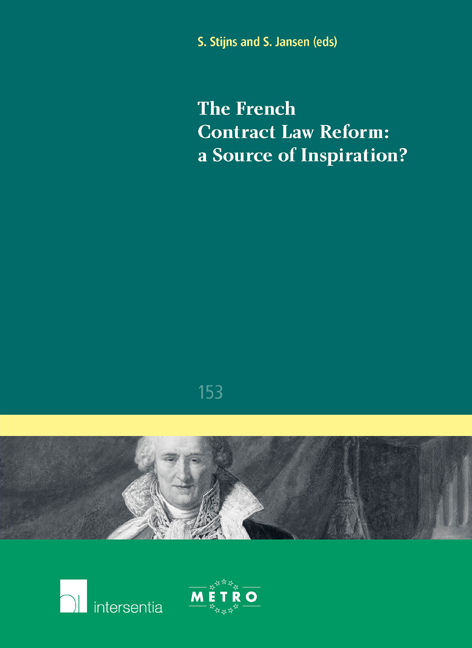Book contents
- Frontmatter
- Contents
- Introduction
- The Reform of the French Law of Obligations: How Long will the Belgians Remain Napoleon's Most Loyal Subjects?
- Pre-Contractual Phase: Reflections on the Attractiveness of the New French Rules for the Parties to International Commercial Transactions
- Nullity in the Ordonnance
- A Tale of Novelty and Continuity: Exploring the Future Judicial Control of Employment Contracts in the French Contract Law Reform
- Introducing Imprévision into French Contract Law - A Paradigm Shift in Comparative Perspective
- Commercial Impracticability and the Missed Opportunity of the French Contract Law Reform: Doctrinal, Historical and Law and Economics Arguments - Comment on Lutzi's Introducing Imprévision into French Contract Law
- Price Reduction under the French Contract Law Reform
- The Measure of Damages in the French Contract Law Reform - Lessons from far more Inspiring Systems
- Set-off in the French Reform of the Law of Obligations: a Tale of Missed Opportunities?
- Fundamental Rights in the French Contract Law Reform
- Miscellaneous Endmatter
Introduction
Published online by Cambridge University Press: 15 December 2017
- Frontmatter
- Contents
- Introduction
- The Reform of the French Law of Obligations: How Long will the Belgians Remain Napoleon's Most Loyal Subjects?
- Pre-Contractual Phase: Reflections on the Attractiveness of the New French Rules for the Parties to International Commercial Transactions
- Nullity in the Ordonnance
- A Tale of Novelty and Continuity: Exploring the Future Judicial Control of Employment Contracts in the French Contract Law Reform
- Introducing Imprévision into French Contract Law - A Paradigm Shift in Comparative Perspective
- Commercial Impracticability and the Missed Opportunity of the French Contract Law Reform: Doctrinal, Historical and Law and Economics Arguments - Comment on Lutzi's Introducing Imprévision into French Contract Law
- Price Reduction under the French Contract Law Reform
- The Measure of Damages in the French Contract Law Reform - Lessons from far more Inspiring Systems
- Set-off in the French Reform of the Law of Obligations: a Tale of Missed Opportunities?
- Fundamental Rights in the French Contract Law Reform
- Miscellaneous Endmatter
Summary
INTRODUCTION
This book is the result of the Contract Law Workshop of the 20th Ius Commune Conference held 26–27 November 2015. The theme of this Workshop was: ‘The French Contract Law Reform: a Source of Inspiration?’ This theme was carefully chosen after the French projet d'ordonnance about contract law, the general regime of obligations and the proof of obligations appeared in February 2015. A few months after our workshop, in February 2016, the fi nal version of the ordonnance was published. The contributions in this book are the proceedings of the presentations of this conference. Since the conference in November 2015, all authors have incorporated comments on the fi nal version of the ordonnance. Whereas Van Loock briefly sketches the antecedents and the outcome of the reform, the other authors tackle each specific topics of the reform that surprised and/or excited the legal community. In what follows, we will introduce the contributions of Van Loock, Pannebakker, Peeraer, Leone, Lutzi, Oosterhuis, Jansen, Verkempinck, Storme, and Mahé to the reader.
As already mentioned, the contribution of Van Loock gives a broad overview of the pathway of the French reform. Firstly, it scrutinises the historical antecedents of the reform, the incentives for reform and the first reform projects (the Catala project, the Terré project and a governmental reform proposal). Furthermore, the author discusses and questions the legitimacy and the practicability of the choice to carry out the reform by way of an ordonnance (which involved a significant delegation of the legislative competences to the government) instead of going through the ordinary parliamentary procedure. The contribution also gives a short overview and appreciation of various innovations of the (projet d’) ordonnance. Moreover, he points out the differences between the draft and the final version of the articles, showing that the drafters of the final ordonnance have taken into account propositions received during the public consultation period. He concludes with lessons for a possible Belgian reform of the law of obligations. Indeed, the lessons learnt from the French reform will probably have to be taken into account soon.
- Type
- Chapter
- Information
- Publisher: IntersentiaPrint publication year: 2016



